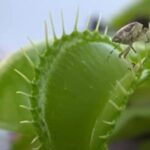As an Amazon Associate, this site earns commissions from qualifying purchases. For more details, click here.
Should Venus flytraps be left outside or kept indoors? It is an ongoing debate and each has their own followers, so as a newbie what do you do? You are in luck because this guide is going to help you make that decision.
Venus flytraps grow best outdoors under direct sunlight. But in very hot climates, you should provide some shade to prevent its leaves from burning. Venus flytraps can also be grown indoors if placed on a window sill with access to the sun or indoor grow lights.
Benefits of Growing Venus Flytraps Outdoors
You can grow Venus flytraps indoors but there are a lot of reasons to leave them outside. These advantages not only benefit the plant but you too, in terms of convenience.
The following are just some of the reasons why a lot of cultivators prefer to leave their Venus flytraps outside. There are different variants of this carnivorous plant, but they all get the following benefits outdoors.
Sunlight
First and foremost, leaving Venus flytraps outdoors exposes them to sunlight. And as you might expect, the more sunlight the better for plants.
Venus flytraps need 6-12 hours of sunlight for optimum growth. They can survive with less, but for best results they need to be under several hours of natural light.
Sunlight is important to these plants for many reasons, but its most critical function is help Venus flytraps create their own food.
Despite popular belief, Venus flytraps do not consume insects for food. They are nutrients and supplement. Their food is glucose which is produced through photosynthesis. And photosynthesis is only possible with light.
There is a lot of debate whether direct or indirect sunlight is better. Direct sunlight is ideal provided it is not so hot. Venus flytraps need sunlight not heat. If the temperature is too high, move the plant so it receives indirect sunlight instead.
Venus flytraps in the growing stage need as much sunlight as possible. You can provide this indoors by positioning them on a window sill. You can also use artificial sources like GooingTop LED Grow Lights if sunlight is limited .
But natural sunlight is still preferred by many. Without sunlight Venus flytraps cannot produce glucose, and without food the plant dies. So even if you decide to grow Venus flytraps indoors, make sure they still have access to light.
Lots of Bugs
Venus flytraps can live without eating bugs, but the benefits are significant. Regular intake of insects provides extra energy so the plant can produce bigger traps, have richer colors and be less vulnerable to disease.
You do not need to feed outdoor Venus flytraps. There are more than enough insects available to meet its nutritional demands.
Carnivorous plants are only found in nutrient poor soil, so they developed other means to acquire these nutrients. In the case of Venus flytraps, they grew traps to lure insects which have the nitrogen they need.
Out in the wild, Venus flytraps can catch all the bugs it needs to compensate for the lack of soil nutrition. Since insects are everywhere, leaving your plant outdoors gives it access to prey 24/7.
Some places have more insects than others and yours might be relatively bug free. But Venus flytraps do not need a lot of them. They consume 4-5 bugs a month, and there is a good chance its traps will catch some outdoors.
We do not recommend feeding Venus flytraps if they are outdoors. There is more than enough insect nutrients available. If you are certain the plant is not getting enough nutrients, you can feed it manually. Do not worry about getting bitten by Venus flytraps.
Most likely though you do not need to feed the traps. Venus flytraps take 5-12 days to consume a bug. They eat 3-5 a month so you should see at least one trap closed all the time. As long as your plant looks healthy there will not be any issues.
Rainwater
Rain showers are good for Venus flytraps, and it saves you the trouble of watering. These plants need plenty of water so rain should not be a cause for concern. If it has been raining consistently, check the soil to make sure it is not soaked.
Venus flytraps require lots of water, but not just any type. Distilled water is the best along with rainwater and reverse osmosis water. Unlike tap water, they do not have any impurities that could harm the plant. A good source is CO-Z 1 Gallon Water Distiller as it does not contain any harmful chemicals.
Can I Leave Venus Flytraps Outside During Winter?
If you are in a hardiness zone 8 or higher, you can leave Venus flytraps outdoors. Bring the plant indoors only if there is prolonged freeze. Mostly though the plant go through dormancy and emerge from it fine. This is the best scenario as Venus flytraps can be outdoors the entire year.
If you are in hardiness zone 4 to 7, you may still leave it outdoors, provided you plant your Venus flytrap in a bog. Do not use a pot because it cannot handle the freezing temperature. Outdoor Venus flytraps in zones 4-7 must be planted in the right soil. Put leaves over the plant to protect it.
If you live in zones 3 and below, bring the plant indoors until it reemerges from dormancy. Place your Venus flytrap on a window sill or the garage without heating.
Growing Venus Flytraps Indoors vs. Outdoors
The best way to grow Venus flytraps is to simulate their natural habitat as much as possible. So growing them outside is ideal in many ways.
We have already gone over the benefits of leaving the plant outdoors so we will not repeat those here. But as we have pointed out, Venus flytraps can be grown indoors fine.
Venus flytraps need the following to grow: light, water, air, nutrition free soil and bugs for supplements. You can provide all those inside your home, but it is more practical outdoors.
Take bugs for instance. Sure you can give Venus flytraps food, and that is what most people do. But if it is outside, you don’t have to do it.
Venus flytraps will live under artificial light. That is what people use when there is not enough sunlight in their area. But you can still give it sunlight even if indoors.. This is why we suggest leaving the plant on a window sill so it can soak up the sun even if indoors.
If you live in zone hardiness 8 or higher, leave your Venus flytrap outside. It will soak up the sun and can survive the winter. The only thing you need to do is water it during summer,. You can top water until the soil is moist, or just leave it sitting in water.
If you want to grow your Venus flytrap indoors, make certain it receives plenty of light – preferably at a not too high temperature- and gets fed 3-5 times a month.
Tips For Growing Venus Flytraps Outside
If you have a new Venus flytrap and want to grow it outside, slowly acclimatize it to direct sunlight. Place the plant by a window with sunlight coming in.
After a week, move the plant outdoors and expose it to direct sunlight for 2-3 hours. After a few days, increase its sunlight exposure by another hour. Keep doing this until your Venus flytrap receives 6-12 hours of sunlight, or whatever is available in your area.
Is it possible to jump start this process? Yes you can place a Venus flytrap in full sunlight right away. Be warned though several leaves will turn black and burn. However new leaves will grow and will be acclimatized to the sun.
Keep an eye on the temperature during summer days. Venus flytraps thrive at 70-95 F (21-35 C). Anything above this could burn its traps. Shade the plant if it gets too hot.
Conclusion
Finding the best place to grow Venus flytraps is the key to success. In most cases, outdoors is really the best scenario, and with the right approach you should see your Venus flytrap grow healthy and strong.

My fascination with carnivorous plants began many, many years ago with Venus Fly Traps. Now I am more than happy to impart what I know with other enthusiasts and those who are curious about meat eating plants.



